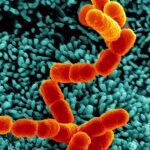Lien vers Pubmed [PMID] – 8698469
Infect. Immun. 1996 Jul;64(7):2474-82
Shigella flexneri-infected macrophage cells undergo an apoptotic-like death as early as one hour after infection (A. Zychlinsky, M. C. Prévost, and P. J. Sansonetti, Nature [London] 358:167-168, 1992). To determine the fate of infected epithelial cells, we characterized the viability, morphology, and several metabolic activities of HeLa cells after treatment with M90T, an invoffve isolate of S. flexneri serotype 5, or BS176, a noninvasive isolate cured of the 220-kb virulence plasmid. Using standard assays, we found that for at least 4 h after infection with M90T, HeLa cells remained viable and did not detach or lyse. The ultrastructural morphology of HeLa cells heavily infected with M90T was free of hallmarks associated with cells undergoing apoptosis. Consistent with the idea that intracellular bacterial growth is metabolically stressful to the host cell, we observed that, compared with BS176 treated-HeLa cells, M90T-treated HeLa cells showed (i) a significant decrease in the total pool size of nucleoside triphosphates, (ii) a reduced ability to incorporate extracellular radiolabeled methionine into the soluble and insoluble cell fractions, and (iii) a stimulation of glucose uptake. However, there was no detectable increase in expression of the stress-inducible hsp70 gene in M90T-infected HeLa cells or activation of the anaerobic metabolic pathway as determined by measuring total lactate levels. These results demonstrate clearly that the fate of S.flexneri-infected cells can vary dramatically between cell types and agree with the hypothesis that the destruction of epithelial cells observed in experimental models of shigellosis is due to the host inflammatory response and probably not bacterial intracellular multiplication per se.

